Hyena
| Hyenas Temporal range: Early Miocene – recent
| |
|---|---|

| |
| The four extant species of hyena, clockwise from upper left: spotted hyena ( Hyaena hyaena )
| |
| Scientific classification | |
| Domain: | Eukaryota |
| Kingdom: | Animalia |
| Phylum: | Chordata |
| Class: | Mammalia |
| Order: | Carnivora |
| Suborder: | Feliformia |
| Superfamily: | Herpestoidea |
| Family: | Hyaenidae Gray, 1821 |
| Type genus | |
Hyaena
, 1762 | |
| Genera | |
| |
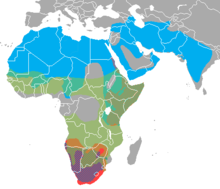
| |
| Synonyms | |
| |
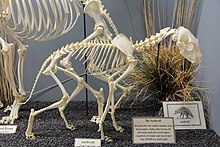
Hyenas or hyaenas (
Although
Hyenas feature prominently in the folklore and mythology of human cultures that live alongside them. Hyenas are commonly viewed as frightening and worthy of contempt. In some cultures, hyenas are thought to influence people's spirits, rob graves, and steal livestock and children.[5] Other cultures associate them with witchcraft, using their body parts in traditional medicine.[6]
Evolution
Origins
Hyenas originated in the jungles of
Rise and fall of the dog-like hyenas
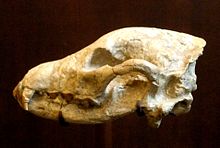
The descendants of Plioviverrops reached their peak 15 million years ago, with more than 30 species having been identified. Unlike most modern hyena species, which are specialised bone-crushers, these dog-like hyenas were nimble-bodied, wolfish animals; one species among them was
Bone-crushing hyenas
By 10–14 million years ago, the hyena family had split into two distinct groups: dog-like hyenas and bone-crushing hyenas. The arrival of the ancestral bone-crushing hyenas coincided with the decline of the similarly built family
Rise of modern hyenas

The four extant species are the striped hyena (Hyaena hyaena), the brown hyena (Parahyaena brunnea), the spotted hyena (Crocuta crocuta), and the aardwolf (Proteles cristata).
The aardwolf can trace its lineage directly back to Plioviverrops 15 million years ago, and is the only survivor of the dog-like hyena lineage. Its success is partly attributed to its insectivorous diet, for which it faced no competition from canids crossing from North America. It is likely that its unrivaled ability to digest the terpene excretions from soldier termites is a modification of the strong digestive system its ancestors used to consume fetid carrion.[7]
The
The
Genera of the Hyaenidae (extinct and recent)
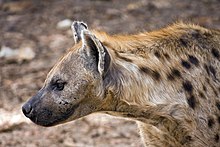
The list follows McKenna and Bell's Classification of Mammals for prehistoric genera (1997)[14] and Wozencraft (2005) in Wilson and Reeders Mammal Species of the World for extant genera.[15] The percrocutids are, in contrast to McKenna and Bell's classification, not included as a subfamily into the Hyaenidae, but as the separate family Percrocutidae (though they are generally grouped as sister-taxa to hyenas[16]). Furthermore, the living brown hyena and its closest extinct relatives are not included in the genus Pachycrocuta, but in the genus Parahyaena. However, some research has suggested Parahyaena may be synonymous with Pachycrocuta, making the brown hyena the only extant member of this genus.[17]
- Family Hyaenidae
- Subfamily Incertae sedis
- †Tongxinictis[18] (Middle Miocene of Asia)
- †Subfamily Ictitheriinae
- †Herpestides (Early Miocene of Africa and Eurasia)
- †Plioviverrops (including Jordanictis, Protoviverrops, Mesoviverrops; Early Miocene to Early Pliocene of Europe, Late Miocene of Asia)
- †Ictitherium (=Galeotherium; including Lepthyaena, Sinictitherium, Paraictitherium; Middle Miocene of Africa, Late Miocene to Early Pliocene of Eurasia)
- †Thalassictis (including Palhyaena, Miohyaena, Hyaenictitherium, Hyaenalopex; Middle to Late Miocene of Asia, Late Miocene of Africa and Europe)
- †Hyaenotherium (Late Miocene to Early Pliocene of Eurasia)
- †Miohyaenotherium[19](Late Miocene of Europe)
- †Lycyaena (Late Miocene of Eurasia)
- †Tungurictis[20] (Middle Miocene of Africa and Eurasia)
- †Protictitherium (Middle Miocene of Africa and Asia, Middle to Late Miocene of Europe)
- Subfamily Hyaeninae
- †Palinhyaena[21] (Late Miocene of Asia)
- †Ikelohyaena[22] (Early Pliocene of Africa)
- Hyaena (=Euhyaena,=Parahyaena; including striped hyena, Pliohyaena, Pliocrocuta, Anomalopithecus) Early Pliocene (?Middle Miocene) to Recent of Africa, Late Pliocene (?Late Miocene) to Late Pleistocene of Europe, Late Pliocene to recent in Asia
- Parahyaena (=Hyaena; brown hyenaPliocene to recent of Africa)
- †Hyaenictis[23] (Late Miocene of Asia?, Late Miocene of Europe, Early Pliocene (?Early Pleistocene) of Africa)
- †Leecyaena[21] (Late Miocene and/or Early Pliocene of Asia)
- †Chasmaporthetes (=Ailuriaena; including Lycaenops, Euryboas; Late Miocene to Early Pleistocene of Eurasia, Early Pliocene to Late Pliocene or Early Pleistocene of Africa, Late Pliocene to Early Pleistocene of North America)
- †Pachycrocuta (Pliocene and Pleistocene of Eurasia and Africa)
- †Adcrocuta (Late Miocene of Eurasia)
- Crocuta (=Crocotta; including Eucrocuta; spotted hyena and cave hyena. Late Pliocene to recent of Africa, Late Pliocene to Late Pleistocene of Eurasia)
- Subfamily Protelinae
- †Gansuyaena[24]
- Proteles (=Geocyon; aardwolf. Pleistocene to Recent of Africa)
- Subfamily Incertae sedis
Phylogeny
The following cladogram illustrates the phylogenetic relationships between extant and extinct hyaenids based on the morphological analysis by Werdelin & Solounias (1991),[25] as updated by Turner et al. (2008).[26]
| ||||||||||||||||||||||||||||||||||||||||||||||||||||||||||||||||||||||||||||||||||||||||||||||||||||||||||||||||||||||||||||||||||||||||||||||||||||||||||||||||||||||||||||||||||||||||||||||||||||||||||||||||||||||||||||||||||||||||||||||||||||||||||||||||||||||||||||||||||||||||||||||||||||||||||||||||||||||||||||||||||||||||||||||
Phylogenic relationships based on morphological characteristics, after Werdelin & Solounias (1991) and Turner et al (2008) |
||||||||||||||||||||||||||||||||||||||||||||||||||||||||||||||||||||||||||||||||||||||||||||||||||||||||||||||||||||||||||||||||||||||||||||||||||||||||||||||||||||||||||||||||||||||||||||||||||||||||||||||||||||||||||||||||||||||||||||||||||||||||||||||||||||||||||||||||||||||||||||||||||||||||||||||||||||||||||||||||||||||||||||||
A more recent molecular analysis agrees on the phylogenetic relationship between the four extant hyaenidae species (Koepfli et al, 2006[27]).
| Hyaenidae |
| ||||||||||||||||||||||||
Characteristics
Build

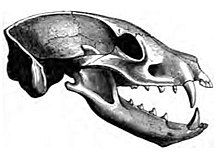
Hyenas have relatively short torsos and are fairly massive and
Their
Although hyenas lack
Behavior

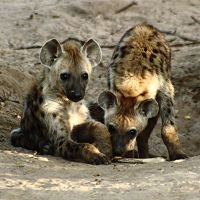
Hyenas
The striped hyena is primarily a scavenger, though it will also attack and kill any animals it can overcome,
Relationships with humans
Folklore, mythology and literature
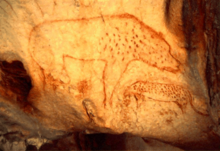

Spotted hyenas vary in their folkloric and mythological depictions, depending on the ethnic group from which the tales originate. It is often difficult to know whether spotted hyenas are the specific hyena species featured in such stories, particularly in West Africa, as both spotted and striped hyenas are often given the same names. In western African tales, spotted hyenas are sometimes depicted as bad
Striped hyenas are often referred to in Middle Eastern literature and folklore, typically as symbols of treachery and stupidity.
The striped hyena is mentioned in the
The vocalization of the spotted hyena resembling hysterical human
Die Strandjutwolf (The brown hyena) is an allegorical poem by the renowned South African poet, N. P. van Wyk Louw, which evokes a sinister and ominous presence.[citation needed]
Attacks on humans

In ordinary circumstances, striped hyenas are extremely timid around humans, though they may show bold behaviors towards people at night.[64] On rare occasions, striped hyenas have preyed on humans.
Among hyenas, only the spotted and striped hyenas have been known to become
Although spotted hyenas have been known to prey on humans in modern times, such incidents are rare. However, attacks on humans by spotted hyenas are likely to be underreported.
In the 1880s, a hyena was reported to have attacked humans, especially sleeping children, over a three-year period in the
Hyenas as food and medicine
Hyenas are used for food and medicinal purposes in
References
Citations
- ^ ὕαινα, Henry George Liddell, Robert Scott, A Greek-English Lexicon, on Perseus. Etymologically, this is a feminine of ὕς "swine".
- ISBN 978-84-96553-49-1.
- ^ Mills & Hofer 1998, p. iv
- ^ Kruuk 1972, p. 274
- ^ Mills & Hofer 1998, p. 96
- PMID 25947365.
- ^ a b c d e f g h i Macdonald 1992, pp. 119–144
- ISSN 0277-3791.
- ^ Kurtén 1968, pp. 66–68
- ^ Mills & Hofer 1998, p. 1
- ^ a b Kurtén 1968, pp. 69–72
- ^ "Comparative ecology and taphonomy of spotted hyenas, humans, and wolves in Pleistocene Italy" (PDF). C. Stiner, Mary. Revue de Paléobiologie, Genève. Retrieved 2008-09-16.
- ISSN 0277-3791.
- ISBN 0-231-11013-8
- OCLC 62265494.
- S2CID 23918004.
- doi:10.26879/1372.
- PMID 30648005.
- .
- .
- ^ .
- .
- S2CID 23453043.
- doi:10.19615/j.cnki.2096-9899.211025 (inactive 31 January 2024).)
{{cite journal}}: CS1 maint: DOI inactive as of January 2024 (link - ISBN 8200374815.
- .
- PMID 16503281.
- ^ a b Heptner & Sludskii 1992, p. 3
- ^ a b c Pocock 1941, pp. 62–63
- ^ a b Heptner & Sludskii 1992, pp. 4–5
- ^ Holl, William & Wood, Neville The Analyst: a quarterly journal of science, literature, natural history, and the fine arts, Volume 10, p. 59, Simpkin & Marshall, 1840
- ^ Mills & Hofer 1998, p. 21
- ^ Kruuk 1972, pp. 210–211
- .
- ^ Daniel Johnson (1827) Sketches of Indian Field Sports: With Observations on the Animals; Also an Account of Some of the Customs of the Inhabitants; with a Description of the Art of Catching Serpents, as Practiced by the Conjoors and Their Method of Curing Themselves when Bitten: with Remarks on Hydrophobia and Rabid Animals p. 45-46, R. Jennings, 1827
- ^ a b Stevenson-Hamilton, James (1917) Animal life in Africa, Vol. 1, p.95, London : William Heinemann
- ^ Salleh, Anna (4 April 2005). "Marsupial has the deadliest bite". abc.net.au. Retrieved 24 January 2013.
- PMID 15817436.
- ISBN 0-87196-871-1.
- ^ Kruuk 1972, p. 222
- ^ Heptner & Sludskii 1992, p. 38
- ^ a b c Kruuk 1972, pp. 271–73
- ^ a b c Pocock 1941, p. 72
- ^ Mills & Mills 2010, pp. 60–61
- ^ Kruuk 1972, p. 220
- ^ Pocock 1941, p. 73
- ^ Kruuk 1972, pp. 247–249
- ^ Rosevear 1974, p. 350
- ^ Heptner & Sludskii 1992, pp. 40–42
- ^ Heptner & Sludskii 1992, pp. 31–33
- ^ Hyaena Specialist Group - Spotted Hyena: Diet and Foraging Archived 2011-02-04 at the Wayback Machine. Hyaenidae.org. Retrieved on 2015-11-06.
- ^ Rosevear 1974, pp. 343–344
- PMID 11742089.
- PMID 26444876.
- PMID 27833242.
- PMID 22173276.
- PMID 24488231.
- ^ a b c d e f Frembgen, Jürgen W. The Magicality of the Hyena: Beliefs and Practices in West and South Asia Archived 2016-04-12 at the Wayback Machine, Asian Folklore Studies, Volume 57, 1998: 331–344
- ^ a b Mills & Hofer 1998, p. 97
- ^ "The spotted hyena from Aristotle to the Lion King: reputation is everything - In the Company of Animals". Stephen E. Glickman. Archived from the original on 2011-08-11. Retrieved 2007-05-22.
- ^ a b c Mounir R. Abi-Said (2006) Reviled as a grave robber: The ecology and conservation of striped hyaenas in the human dominated landscapes of Lebanon Ph.D. thesis, University of Kent (Biodiversity management)
- ISBN 0-448-23170-0.
- ^ ISBN 1-86105-831-4.
- ^ Heptner & Sludskii 1992, p. 36
- ^ Viegas, Jennifer (10 February 2009). "Oldest Human Hair Found in Fossilized Dung". Discovery News. Archived from the original on 7 January 2010. Retrieved 29 November 2020.
- ^ "Hyenas and Humans in Ice Age Siberia" (PDF). Christy G. Turner II. School of Human Evolution and Social Change, Arizona State University. Retrieved 2008-08-02.[dead link]
- ISBN 0-679-72203-3
- ISBN 0-520-21329-7
- ISBN 1-56324-300-8
- ^ a b c Begg, Colleen, Begg, Keith & Muemedi, Oscar (2007) Preliminary data on human - carnivore conflict in Niassa National Reserve, Mozambique, particularly fatalities due to lion, spotted hyaena and crocodile Archived 2011-12-26 at the Wayback Machine, SGDRN (Sociedade para a Gestão e Desenvolvimento da Reserva do Niassa Moçambique)
- ISBN 0-521-89109-4
- ^ ISBN 0-415-22441-1.
- ^ Roosevelt, Theodore (1910) African Game Trails: An Account of the African Wanderings of an American Hunter, Naturalist, New York, C. Scribner's sons
- ^ Heptner & Sludskii 1992, p. 46
- ^ Mills & Hofer 1998, p. 25
- ^ "The Fear of Wolves: A Review of Wolf Attacks on Humans" (PDF). Norsk Institutt for Naturforskning. Archived from the original (PDF) on 2007-09-27. Retrieved 2008-06-26.
- ^ "Islamists authorise hyena meat in Southern Somalia". Somalilandpress. August 12, 2012. Archived from the original on 2017-01-03. Retrieved 2017-01-03.
- ^ "Jami' at-Tirmidhi 851 - The Book on Hajj - كتاب الحج عن رسول الله صلى الله عليه وسلم - Sunnah.com - Sayings and Teachings of Prophet Muhammad (صلى الله عليه و سلم)". sunnah.com.
General and cited references
- Heptner, V. G.; Sludskii, A. A. (1992). Mammals of the Soviet Union: Carnivora (hyaenas and cats), Volume 2. Smithsonian Institution Libraries and National Science Foundation.
- Kruuk, Hans (1972). The Spotted Hyena: A Study of Predation and Social Behaviour. University of California Press.
- Kurtén, Björn (1968). Pleistocene mammals of Europe. Weidenfeld and Nicolson.
- Macdonald, David (1992). The Velvet Claw: A Natural History of the Carnivores. New York: Parkwest. ISBN 0-563-20844-9.
- ISBN 2-8317-0442-1. Archived from the original(PDF) on May 6, 2013.
- ISBN 978-1-77009-811-4.
- Pocock, R. I. (1941). Fauna of British India: Mammals Volume 2. Taylor and Francis.
- Rosevear, Donovan Reginald (1974). The carnivores of West Africa. London: Trustees of the British Museum (Natural History). ISBN 0565007238.
Further reading
- Funk, Holdger (2010) Hyaena: On the Naming and Localisation of an Enigmatic Animal, GRIN Verlag, ISBN 3-640-69784-7.
- Lawick, Hugo & Goodall, Jane (1971) Innocent Killers, Houghton Mifflin Company Boston.
- Mills, M. G. L. (2003) Kalahari Hyenas: Comparative Behavioral Ecology of Two Species, The Blackburn Press.


